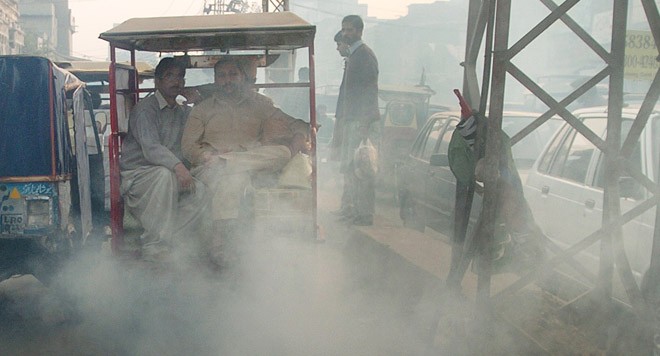

Air pollution has risen to alarming levels in the provincial capital as particulate matter level exceeds its standard 150mg per cubic metre. "In congested areas, the level has reached 250mg per cubic metre even," says Nasim-ur-Rehman, Director, Environmental Protection Agency (EPA). This means the people based in Lahore are exposed to lung and bladder cancers because the air they are breathing has been officially classified as carcinogenic by the World Health Organization’s International Agency for Research on Cancer (IARC).
A recent report by the organisation reveals that in 2010, 223,000 deaths by lung cancer (the world over) resulted from air pollution and there is also convincing evidence that air pollution increases the risk of bladder cancer.
Air pollution, mostly caused by emissions from motor vehicles, power generation, industry, agriculture and also domestic heating and cooking, is already known to increase chances of a wide range of illnesses of respiratory and cardiac kind. TNS learns that unfit vehicles and power shortages are the main factors behind the current rise in air pollution as thousands of motorcycle rickshaws continue to emit dangerous gases in the air.
Director EPA also says the government imposed a total ban on the registration of two-stroke rickshaws in 2005 but they continue to ply on the roads in hordes.
As per the report, the two-stroke auto rickshaws and motorcycle rickshaws discharge poisonous gases such as Volatile Organic Compounds, Nitrogen Oxide, Hydro Carbons, Carbon Dioxide, Lead, Suspended Particulate Matters, Sulphur Dioxide, Aldehydes, Organic Acids and unburned Lubricating Oil. When these gases mix in the air, the latter becomes highly polluted (read poisonous) for human consumption.
Naseem identifies 20 spots in the city which he says should be declared signal-free as traffic congestion increases the risk of polluted air. These spots include Azadi Chowk, Choongi Amar Siddhu, Ferozpur Rd, Canal, Samanabad Morr, Scheme Morr and Kharrak.
"Underpasses or overheads on such spots are part of the plan," he reveals. "The government is keen to make the city clean and beautiful."
According to Naseem, the Railway Station, Choburji, GPO and Azadi Chowk are at greater risk as the particulate matter rate in these areas is found to be 250mg per cubic metre.
Besides, the inhabitants of Northern Lahore face problems because of the location of the steel industry. "Due to power and gas shortages, industrialists look for alternate ways; tyres become their favourite fuel as it proves to be cost effective, though it affects the environment badly."
Azhar Qureshi, a resident of Mehmood Booti, says the area is so polluted that the children in the streets often end up having darkened skin when exposed to air.
Dr Hamid Hassan, Medical Superintendent, Gulab Devi Chest Hospital, the largest facility in the city as far as respiratory ailments are concerned, says the number of patients affected by lung diseases is on the rise and air pollution is among the most common factors. "Earlier we thought such diseases would occur only in old age, but today we see very young people diagnosed with bronchitis, asthma and lung cancer. A majority of them come from urban centres," he adds.
The issue needs a serious attention and genuine effort on the part of the government as there are several agencies like Lahore Transport Company (LTC), Regional Transport Authority (RTA), Environmental Protection Department (EPD) and Motor Mobile Police (MMP) in charge of the traffic sector besides the City Traffic Police. The WHO report blames air pollution to the vehicles plying on the roads 50 percent of which, it says, are unfit.
Motorcycle rickshaw which has been described as an illegal vehicle by the traffic authorities and has no rout permit as a commercial vehicle, is the leading source of air pollution as it has a smoke emitting capacity of 66.3 percent as compared to 5-8 percent of the four-stroke rickshaw and contributes 60 percent to air pollution in the city.
Reportedly, over 40,000 motorcycle rickshaws are running on the roads in the city. A senior official at Regional Transport Authority says there were 34,000 two-stroke rickshaws and 16,000 four-stroke vehicles in Lahore in the year 2009 but due to the ban on new induction, the number of two-stroke has come down considerably to 6,000 and the four-stroke rickshaws have increased to 25,000 in number.
There are almost four million vehicles in Lahore and, given the above figures, the situation looks like it will assume dreadful proportions if not checked.